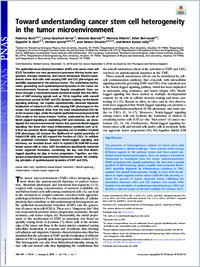Toward understanding cancer stem cell heterogeneity in the tumor microenvironment.
- Bocci F Center for Theoretical Biological Physics, Rice University, Houston, TX 77005.
- Gearhart-Serna L Department of Surgery, Division of Surgical Sciences, Duke University School of Medicine, Durham, NC 27710.
- Boareto M Department of Biosystems Science and Engineering, ETH Zurich, 4058 Basel, Switzerland.
- Ribeiro M Department of Surgery, Division of Surgical Sciences, Duke University School of Medicine, Durham, NC 27710.
- Ben-Jacob E Center for Theoretical Biological Physics, Rice University, Houston, TX 77005.
- Devi GR Department of Surgery, Division of Surgical Sciences, Duke University School of Medicine, Durham, NC 27710; gayathri.devi@duke.edu herbert.levine@rice.edu jonuchic@rice.edu mkjolly@iisc.ac.in.
- Levine H Center for Theoretical Biological Physics, Rice University, Houston, TX 77005; gayathri.devi@duke.edu herbert.levine@rice.edu jonuchic@rice.edu mkjolly@iisc.ac.in.
- Onuchic JN Center for Theoretical Biological Physics, Rice University, Houston, TX 77005; gayathri.devi@duke.edu herbert.levine@rice.edu jonuchic@rice.edu mkjolly@iisc.ac.in.
- Jolly MK Center for Theoretical Biological Physics, Rice University, Houston, TX 77005; gayathri.devi@duke.edu herbert.levine@rice.edu jonuchic@rice.edu mkjolly@iisc.ac.in.
- 2018-12-28
Published in:
- Proceedings of the National Academy of Sciences of the United States of America. - 2019
Notch signaling
breast tumor organoids
cancer stem cells
epithelial–mesenchymal transition
inflammation
Breast Neoplasms
Cytokines
Epithelial-Mesenchymal Transition
Female
Gene Knockdown Techniques
Humans
Neoplastic Cells, Circulating
Neoplastic Stem Cells
Phenotype
Receptors, Notch
Signal Transduction
Transforming Growth Factor beta
Tumor Microenvironment
English
The epithelial-mesenchymal transition (EMT) and cancer stem cell (CSC) formation are two paramount processes driving tumor progression, therapy resistance, and cancer metastasis. Recent experiments show that cells with varying EMT and CSC phenotypes are spatially segregated in the primary tumor. The underlying mechanisms generating such spatiotemporal dynamics in the tumor microenvironment, however, remain largely unexplored. Here, we show through a mechanism-based dynamical model that the diffusion of EMT-inducing signals such as TGF-β, together with noncell autonomous control of EMT and CSC decision making via the Notch signaling pathway, can explain experimentally observed disparate localization of subsets of CSCs with varying EMT phenotypes in the tumor. Our simulations show that the more mesenchymal CSCs lie at the invasive edge, while the hybrid epithelial/mesenchymal (E/M) CSCs reside in the tumor interior. Further, motivated by the role of Notch-Jagged signaling in mediating EMT and stemness, we investigated the microenvironmental factors that promote Notch-Jagged signaling. We show that many inflammatory cytokines such as IL-6 that can promote Notch-Jagged signaling can (i) stabilize a hybrid E/M phenotype, (ii) increase the likelihood of spatial proximity of hybrid E/M cells, and (iii) expand the fraction of CSCs. To validate the predicted connection between Notch-Jagged signaling and stemness, we knocked down JAG1 in hybrid E/M SUM149 human breast cancer cells in vitro. JAG1 knockdown significantly restricted tumor organoid formation, confirming the key role that Notch-Jagged signaling can play in tumor progression. Together, our integrated computational-experimental framework reveals the underlying principles of spatiotemporal dynamics of EMT and CSCs.
- Language
-
- English
- Open access status
- bronze
- Identifiers
-
- DOI 10.1073/pnas.1815345116
- PMID 30587589
- Persistent URL
- https://sonar.ch/global/documents/55039
Statistics
Document views: 27
File downloads:
- fulltext.pdf: 0
